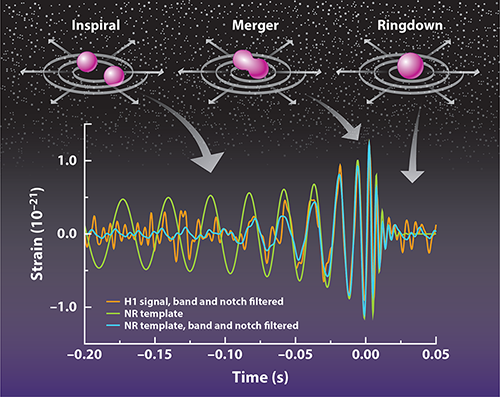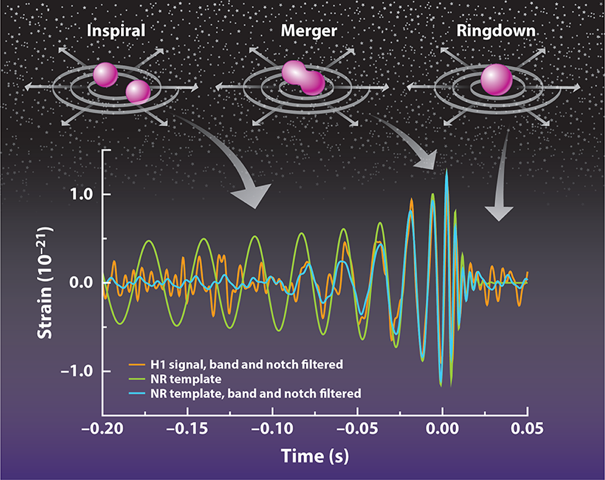Relativity Gets Thorough Vetting from LIGO
On September 14, 2015, the LIGO interferometers made the first direct measurement of gravitational waves [1]. The historic discovery came nearly 100 years after Einstein showed that his general relativity theory predicts the existence of gravitational waves and over 50 years since the first quest to observe the Universe in gravitational waves [2]. The observed event, labeled GW150914, was the collision of two black holes, one weighing 29 solar masses, the other 36 solar masses. This binary coalesced into a remnant black hole weighing 62 solar masses and rotating at 67% the maximum rate allowed for a black hole. The most statistically significant portion of the signal came from the last several gravitational-wave cycles of the collision, where the most nonlinear, strong-field dynamics of the theory manifest. One couldn’t have asked for a better first event to learn about this regime of general relativity.
The first thing that GW150914 can teach us is how closely nature follows Einstein’s prescriptions for colliding black holes. Researchers from the LIGO team and the Virgo team have performed a series of tests to see if any violations of general relativity might be lurking in the data of GW150914 [3]. They first determined the theoretical waveform, or “template,” from general relativity simulations that best fit the measured signal (see Fig. 1). Their main finding is that the residual signal—obtained by subtracting this template from the data—is consistent with noise. This is, in a sense, the “everything” test, as the template folds in all that general relativity predicts about the merger: the decay of the last few orbits of the two black holes, their violent collision and astonishingly rapid relaxation to a quiescent rotating black hole, the propagation of gravitational waves through the cosmos, and finally the transformation of these waves into a chirp in the LIGO detectors. Given the large signal-to-noise ratio of 24, the close agreement between the template and the data puts limits on alternative models. Specifically, the predictions of these models can only disagree with the general relativity prediction for GW150914 by, at most, 4%.
In addition to this comprehensive test, the LIGO/Virgo teams also performed other checks that pick apart the signal, in order to address particular aspects of general relativity and black hole physics. In one such test, they compared the early and late parts of the waveform. From the waves generated during the initial inspiral, one can infer the masses and spins of the binary. Given these numbers, general relativity allows the mass and spin of the remnant black hole to be calculated. The researchers compared this result to an independent measurement of the mass and spin obtained from the late-time ringdown, and to within uncertainties, the two estimates were consistent.
Another test isolated coefficients in the so-called Post Newtonian (PN) series describing the inspiral. The PN series is an expansion of the gravitational-wave signal in powers of the velocity v of the sources relative to the speed of light c. Observations of binary pulsars, which show a decrease in their orbital period due to gravitational-wave emission, have constrained PN terms, especially at low order. For higher-order terms associated with strong-field emission, the LIGO/Virgo teams were able to improve the limits by many orders of magnitude compared to the binary pulsar constraints.
At first glance it might seem these new results simply add to the litany of previous tests that general relativity passed with flying colors. However, GW150914 is vastly more significant than that. Other tests have shown that general relativity is valid in the weak-field regime, but GW150914 gives the first direct observational evidence that general relativity is the correct theory of nature governing the extreme spacetime dynamics around the event horizon of a black hole. One could argue that binary pulsar observations already told us that gravitational waves exist [4], but GW150914 is more luminous in gravitational waves than pulsar binaries by at least 24 orders of magnitude. It’s true that the evolution of the Universe as a whole is driven by strong gravity, but it would be difficult to argue that precision cosmological measurements can constitute a test of general relativity when one of the dominant inputs, dark energy, is still a mystery.
As far as black holes are concerned, astronomers have observed ultracompact dark objects that are consistent with black holes. The most striking data comes from stellar orbits about the 4 million solar mass object in the center of our Galaxy [5], but present observations cannot constrain it to be a black hole as described by general relativity. GW150914 has given us the first morsels of quantifiable evidence that the rich physics of black holes is as predicted by general relativity. For example, the LIGO observations are consistent with so-called cosmic censorship [6], which says that gravitational singularities must remain hidden behind an event horizon. If a “naked” singularity were produced in the energetic collision of GW150914, the data would likely have shown some sort of anomaly, but in exactly what form, we don’t know. Another example involves the “no-hair” theorem [7], which says that the only properties of a black hole are its mass, spin, and charge (though astrophysical black holes are expected to have negligible charge). By consequence, these properties should determine the frequency and decay constants of all the infinitely many ringdown modes of a black hole. With GW150914, only the least-damped ringdown mode is visible above the noise, but when combined with the remnant mass and spin inferred from the inspiral, this is enough to count as the first piece of evidence for a black hole’s baldness.
GW150914 should also be a test for alternative theories of gravity or exotic alternatives to black holes within general relativity, such as boson stars [8]. Some of these alternative models are concerned with explaining dark energy or dark matter and do not, therefore, predict any deviation from relativity at the scale of GW150914. However, other models do in fact deviate from conventional relativity in their predictions of the gravitational-wave signal from a binary merger. The largest deviations should presumably occur during the last several gravitational-wave cycles, where the signal is strong, and deviations should be easy to detect or constrain. Embarrassingly though, the majority of alternatives that claim deviations can't really say much about this event, as the two-body problem hasn’t been solved in these theories. These models can only reproduce a fraction of the full gravitational-wave signal, so the strong constraints one might have hoped for cannot be leveled. Exotic alternatives within general relativity are in a similar boat, or worse for objects like gravastars, which have no well-defined theoretical framework to say what happens when two such objects collide. Regardless, what is clear from the data is that any non-black-hole solution must imagine a form of exotic matter with a viscosity larger than any known material to explain the rapid damping of oscillations observed during the ringdown.
The inferred event rate for heavy black hole mergers like GW150194 is high, and LIGO has another factor of 3 improvement in sensitivity slated before it reaches design sensitivity. Within 5 years then, we can expect dozens of detected events, with the loudest having a signal-to-noise ratio upwards of 100. This will allow for exquisite insight into the nature of extreme gravity beyond what GW150194 has already gifted us with.
This research is published in Physical Review Letters.
References
- B. P. Abbott et al. (LIGO Scientific Collaboration and Virgo Collaboration), “Observation of Gravitational Waves from a Binary Black Hole Merger,” Phys. Rev. Lett. 116, 061102 (2016).
- J. Weber, “Detection and Generation of Gravitational Waves,” Phys. Rev. 117, 306 (1960).
- B. P. Abbott et al. (LIGO Scientific Collaboration and Virgo Collaboration), “Tests of General Relativity with GW150914,” Phys. Rev. Lett. 116, 221101 (2016).
- R. A. Hulse and J. H. Taylor, “Discovery of a Pulsar in a Binary System,” Astrophys. J. 195, 51 (1975).
- A. Eckart and R. Genzel, “Stellar Proper Motions in the Central 0.1 pc of the Galaxy,” Mon. Not. R. Astron. Soc. 284, 576 (1997); A. M. Ghez et al., “High Proper-Motion Stars in the Vicinity of Sagittarius A*: Evidence for a Supermassive Black Hole at the Center of Our Galaxy,” Astrophys. J. 509, 678 (1998).
- R. Penrose, “Structure of Spacetime,” Batteles Rencontre: 1967 Lectures in Mathematics and Physics, edited by C. M. DeWitt, and J. A. Wheeler (Benjamin, New York, 1968).
- W. Israel, “Event Horizons in Static Vacuum Space-Times,” Phys. Rev. 164, 1776 (1967); B. Carter, “Axisymmetric Black Hole Has Only Two Degrees of Freedom,” Phys. Rev. Lett. 26, 331 (1971); D. C. Robinson, “Uniqueness of the Kerr Black Hole,” 34, 905 (1975).
- N. Yunes et al., “Theoretical Physics Implications of the Binary Black-Hole Merger GW150914,” arXiv:1603.08955 .
- https://losc.ligo.org/events/GW150914/.





